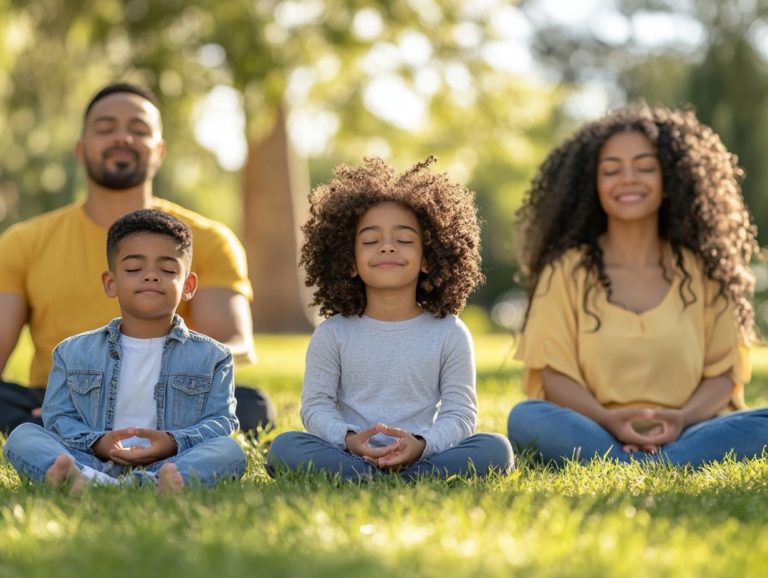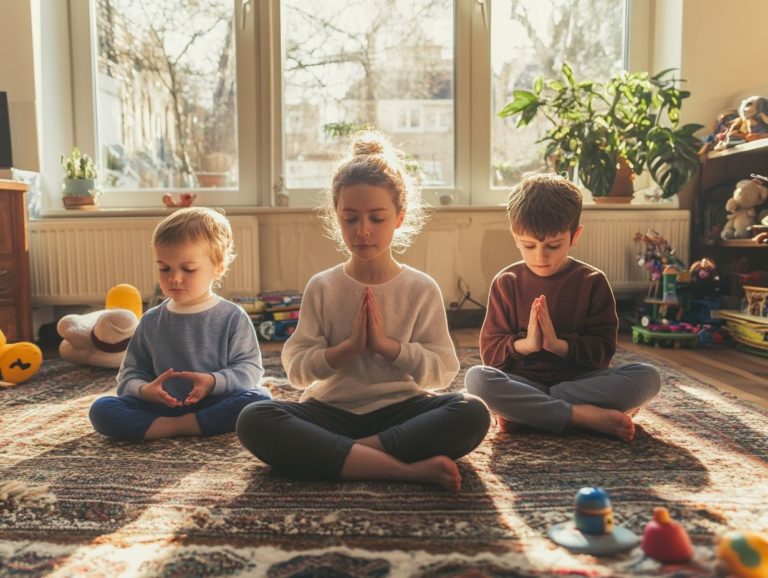5 Easy Mindfulness Techniques to Teach Children
In today s fast-paced world, teaching mindfulness to children can profoundly enhance their emotional well-being, mental resilience, and personal growth. This article delves into five simple yet effective mindfulness techniques such as mindful breathing, gratitude practice, and sensory awareness exercises that you can seamlessly weave into daily routines.
You’ll explore the significance of mindfulness for children and how it empowers them to manage their emotions. It also offers practical tips tailored for parents and educators alike, including calming activities and breathing techniques. These techniques are particularly beneficial for children facing challenges such as learning disabilities or attention-deficit hyperactivity disorder.
This article also clears up common misconceptions surrounding mindfulness practices. Discover how these strategies can truly enrich the lives of the children in your care!
Contents
- Quick Highlights
- Key Takeaways:
- 1. Mindful Breathing and Breath Practices
- 2. Body Scan Meditation and Grounding Exercises
- 3. Gratitude Practice
- 4. Mindful Coloring
- 5. Sensory Awareness Exercise
- Why Is Mindfulness Important for Children and Their Developmental Stages?
- How Can Mindfulness Help Children with Their Emotions and Attention Skills?
- What Are the Benefits of Teaching Mindfulness to Children and Their Thinking Skills?
- How Can Mindfulness Be Incorporated into Daily Activities?
- What Are Some Tips for Teaching Mindfulness to Children?
- What Are Some Common Misconceptions About Mindfulness for Children?
- Frequently Asked Questions
- Teaching Mindfulness to Children
Quick Highlights
Key Takeaways:
- Engage children in mindful breathing to calm their minds and bodies, helping them relax.
- Use body scan meditation to help children become more aware of their physical sensations, promoting tension release.
- Encourage gratitude practice to instill a sense of appreciation and positivity in children, fostering gratefulness.
1. Mindful Breathing and Breath Practices
Mindful breathing serves as a fundamental practice that enables you to help children cultivate self-awareness understanding their feelings and reactions and emotional regulation. It provides a safe haven for them to explore their feelings and nurture a calm focus amidst the daily chaos.
This practice significantly aids in stress management and anxiety relief. By introducing breathing techniques like balloon belly breathing and other breath practices, you empower them to manage stress levels and enhance their emotional health, ultimately fostering resilience and relief from anxiety.
Incorporating methods such as 4-7-8 breathing, counting breaths, and sound meditation invites children to connect both physically and emotionally with their breath. This connection allows them to recognize and articulate their feelings more effectively.
Establishing a dedicated space be it a cozy corner adorned with soft cushions or a quiet room can elevate the experience significantly. This ensures children feel secure and supported as they practice these techniques. This nurturing environment, or safe place, gives them the power to engage fully in mindful breathing exercises, reinforcing positive associations with emotional regulation and stress management.
2. Body Scan Meditation and Grounding Exercises
Body scan meditation is an incredibly impactful mindfulness practice that invites you to connect with your body. It enhances self-awareness and emotional regulation through focused attention on physical sensations, serving as effective grounding exercises.
As you guide children through this methodical exploration of their physical selves, they learn to pinpoint areas of tension and discomfort. This fosters a deep sense of comfort and familiarity with their own bodily signals. Start the practice by having them sit or lie comfortably and encourage them to close their eyes and take deep, soothing breaths.
Starting from the tips of their toes, they can slowly move upward through each part of the body, paying close attention to how each area feels, thus promoting relaxation. This intentional focus not only teaches them to recognize their body s signals but also bolsters emotional regulation.
As a result, children can process feelings of stress, anxiety, or restlessness more effectively. They cultivate a greater sense of calm and balance, paving the way for more effective emotional responses in challenging situations.
Try incorporating mindful breathing today and watch your child thrive!
3. Gratitude Practice
A gratitude practice is an essential component of mindfulness that enables you to help children cultivate positive emotions and enhance their overall emotional health. By encouraging them to regularly reflect on what they appreciate in their lives through gratefulness exercises, you lay a foundation for emotional well-being.
One effective method is to maintain a gratitude journal, where children can jot down daily entries about what fills them with thankfulness. This simple yet impactful exercise invites them to focus on the positive, reinforcing their ability to discover joy in everyday moments.
Sharing daily highlights with family members can create a nurturing atmosphere, fostering deeper connections and encouraging open discussions about positivity and gratefulness.
By weaving these practices into their routine, children not only build emotional resilience but also learn to celebrate life s small victories. This ultimately shapes a more optimistic outlook as they navigate life’s challenges.
4. Mindful Coloring
Dive into the vibrant world of mindful coloring! This delightful avenue allows children to engage in creative expression while sharpening their mindfulness skills.
It serves as a therapeutic outlet that nurtures emotional health and enhances focus. This enriching activity invites you to immerse yourself fully in the present moment, allowing stress and worries to fade as you explore a vibrant array of colors and patterns.
As children thoughtfully select their colors, they learn to articulate their feelings and thoughts, leading to a deeper understanding of their emotions. To elevate the experience, consider using high-quality colored pencils, markers, or even watercolors to inspire creativity.
Incorporating techniques such as mandalas, intricate designs, or nature-themed images can further ignite imagination and foster a sense of calm. Engaging in mindful coloring results in beautiful artwork and cultivates a peaceful, reflective state of mind.
This activity can be even more enriching by embracing music or nature sounds in the background.
5. Sensory Awareness Exercise
Engaging in sensory awareness exercises allows you to immerse yourself in the present moment, exploring the world around you through your senses. This practice enhances your emotional regulation, which is the ability to manage your feelings, and mindfulness, serving as grounding exercises.
Consider conducting these activities outdoors, where you can actively engage with the captivating sights, sounds, and textures of nature. For instance, picture yourself sitting quietly on a grassy knoll, feeling the cool breeze gently caress your skin and listening to the soothing rustle of leaves overhead.
By concentrating on these sensory details, you sharpen your attention skills and cultivate a profound connection to your environment. This promotes emotional balance and alleviates anxiety.
Nature serves as a tranquil backdrop, reinforcing your sense of peace and well-being as you learn to appreciate your surroundings through mindful observation. This can be especially beneficial for children with learning disabilities and attention-deficit hyperactivity disorder.
Why Is Mindfulness Important for Children and Their Developmental Stages?
Mindfulness holds significant importance for children, as it establishes a strong foundation for emotional health and social-emotional learning. By embracing mindfulness, you enable them to build important life skills such as self-awareness, attention management, and emotional regulation, all of which profoundly impact their mental well-being, developmental stages, and academic success.
Incorporating mindfulness into their daily routines empowers children to navigate stress more effectively and enhances their ability to concentrate amidst distractions an increasingly vital skill in today s fast-paced world.
When children understand their emotions and engage in mindful breathing, meditation, or kindness meditation, they often experience reduced anxiety levels. This leads to more positive interactions with peers and adults alike.
By integrating these practices into educational settings, you foster a more supportive learning environment while promoting a holistic approach to development. This approach allows children to flourish both academically and personally as they build resilience and empathy, equipping them for a brighter future.
Mindful activities like “legs up the wall” provide physical and mental relaxation.
How Can Mindfulness Help Children with Their Emotions and Attention Skills?
Mindfulness can be a powerful tool for children, enabling them to manage their emotions more effectively. By enhancing their ability to recognize and regulate feelings, mindfulness leads to significant reductions in stress and anxiety. This ultimately fosters better emotional health and attention skills.
When children engage in mindfulness techniques like deep breathing exercises, body scans, and guided imagery, they learn to tune into their feelings without judgment. For example, practicing simple breathing techniques can help them find calmness when they feel overwhelmed. These activities serve as excellent calming practices during stressful times.
Teaching children to identify their emotions through mindfulness is exciting! It helps them connect better with others and cultivate empathy and understanding in their interactions with peers and adults.
This increased emotional awareness supports conflict resolution and strengthens relationships. Children become more adept at expressing their emotions, paving the way for healthier social dynamics and compassionate communication.
What Are the Benefits of Teaching Mindfulness to Children and Their Thinking Skills?
Teaching mindfulness to children offers a wealth of benefits, including enhanced emotional health, improved academic performance, and increased mental resilience. These benefits strengthen their thinking skills and equip them with essential tools to navigate life’s challenges effectively.
Research indicates that incorporating mindfulness practices in educational settings can significantly sharpen children’s attention skills, enabling them to focus more effectively on their studies. A study published in the journal ‘Psychology in the Schools’ found that children who engaged in mindfulness programs showed improved concentration and experienced fewer behavioral issues.
Engaging in activities like “warrior pose” and “mind garden” enriches their mindfulness journey. Experts emphasize that mindfulness promotes emotional regulation, allowing children to manage stress and anxiety with greater ease.
This emotional toolkit enhances their well-being. It also contributes to higher academic achievement, underscoring the importance of these practices in nurturing well-rounded individuals ready to tackle the complexities of the modern world.
By embracing mindfulness, children cultivate resilience, setting the stage for lifelong success.
How Can Mindfulness Be Incorporated into Daily Activities?
Incorporating mindfulness into your child’s daily activities can transform routine tasks into enriching experiences that foster self-awareness and emotional regulation, significantly enhancing their overall well-being.
Encourage your child to practice mindfulness during meals by noticing the vibrant colors, intriguing textures, and delightful smells of their food. This simple approach turns an ordinary mealtime into a captivating sensory exploration.
As an educator, harness the power of mindfulness during art projects by prompting students to focus on their breathing and the sensation of the paintbrush gliding across the canvas. Incorporating breathing exercises before transitioning between subjects grounds students and prepares them mentally, ultimately boosting their creative output.
These practices emphasize creativity and highlight the importance of grounding oneself in the present moment. This can profoundly enhance social interactions and emotional resilience.
What Are Some Tips for Teaching Mindfulness to Children?
Teaching mindfulness to children can be both effective and enjoyable when you incorporate a few thoughtful strategies. Consider using breathing techniques, creative expression, and engaging activities that resonate with their interests and developmental stages.
A practical approach involves blending short meditative moments with fun activities like mindful coloring or nature walks. This helps children truly connect with their world and their feelings in a meaningful way.
Creating a supportive environment is crucial. Think about establishing a dedicated calming space that features soft cushions, soothing visuals, and gentle sounds to invite relaxation and tranquility.
Organizing group mindfulness sessions where kids can practice together can significantly enhance their sense of community. Encourage open discussions about emotions. Helping children express their feelings and experiences fosters self-awareness and builds their emotional resilience.
What Are Some Common Misconceptions About Mindfulness for Children?
You may encounter several common misconceptions about mindfulness for children, such as the belief that it is solely about relaxation or that it demands an extensive time commitment. These misunderstandings can actually hinder its integration into daily life and emotional health practices.
Many assume that mindfulness is just a tool for calming down in stressful situations, but it s much more versatile than that. You can practice mindfulness in short intervals, making it perfectly feasible for even the youngest children to engage in meaningful mindfulness activities throughout their day.
For instance, you can easily incorporate simple breathing exercises or moments of focused observation into routine activities like eating or walking. By making mindfulness accessible to children, you not only support their emotional development but also help them build resilience in coping with stress and anxiety through 5 breathing techniques for mindful parenting.
By dispelling these myths and highlighting its adaptability, mindfulness can become a valuable resource for nurturing emotional well-being in children.
Frequently Asked Questions
What are some easy mindfulness techniques to teach children?
- Mindful Breathing: Teach children to take deep breaths and focus on the sensation of air filling their lungs and leaving their body. This helps them calm down and be more present in the moment.
- Body Scan: Have children close their eyes and focus on each part of their body, starting from their toes and moving up to their head (a practice of focusing on each part of the body). This helps them tune in to their body and release tension.
- Mindful Coloring: Encourage children to color mindfully, paying attention to the colors, movements, and sensations of their hand as they color. This helps them relax and focus on the present.
- Gratitude Practice: Have children list things they are grateful for or draw pictures of things that make them happy. This helps them cultivate a positive mindset and appreciate the good things in their life.
- Mindful Listening: Have children close their eyes and listen to different sounds around them, from nature to everyday noises. This helps them become more aware of their surroundings and be more present in the moment.
How can I introduce mindfulness to my child?
- Lead by Example: Children learn by observing their parents, so practicing mindfulness yourself can encourage them to do the same.
- Start Small: Don’t overwhelm your child with too many techniques at once. Start with one or two and gradually introduce more as they become comfortable.
- Make it Fun: Incorporate mindfulness into everyday activities like coloring, playing, or going for a walk. This makes it more enjoyable for children and they are more likely to participate.
What are the benefits of teaching mindfulness to children?
- Improved Focus: Mindfulness helps children tune out distractions and focus on the present, which can improve their attention span and concentration.
- Better Emotional Regulation: By teaching children to be more aware of their thoughts and feelings, mindfulness can help them regulate their emotions and cope with difficult situations.
- Reduced Stress and Anxiety: Practicing mindfulness can help children relax and calm their mind, reducing feelings of stress and anxiety.
Try these fun techniques today to boost your child’s well-being! Start implementing mindfulness techniques immediately to nurture emotional health in your children.
Teaching Mindfulness to Children
At What Age Can You Start Teaching Mindfulness?
Mindfulness can be introduced to children as young as 3 or 4 years old. Use simpler techniques and shorter practice sessions at this age!
As children grow older, they can learn advanced techniques and practice for longer periods of time.
Can Mindfulness Be Taught to Children with Special Needs?
Yes! Mindfulness can be beneficial for children with special needs, including those with ADHD, autism, and anxiety.
You may need to modify techniques and adopt a more individualized approach. With the right guidance, mindfulness remains a valuable tool for these children.




